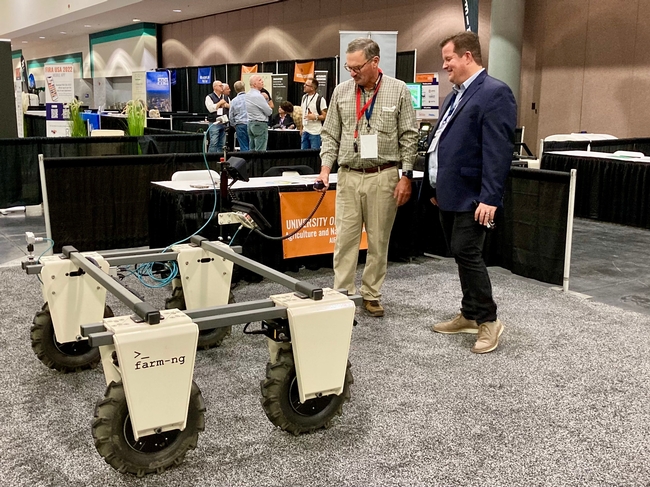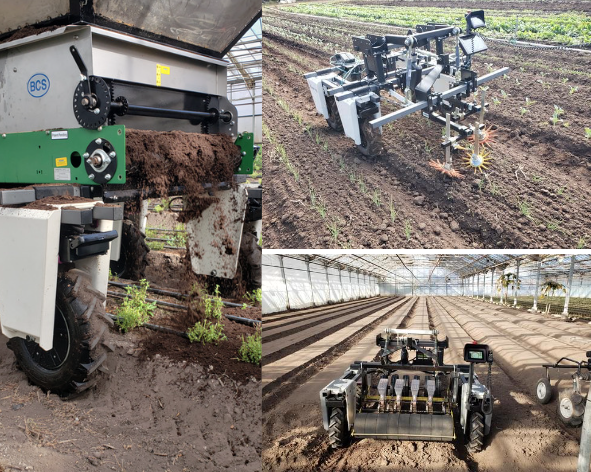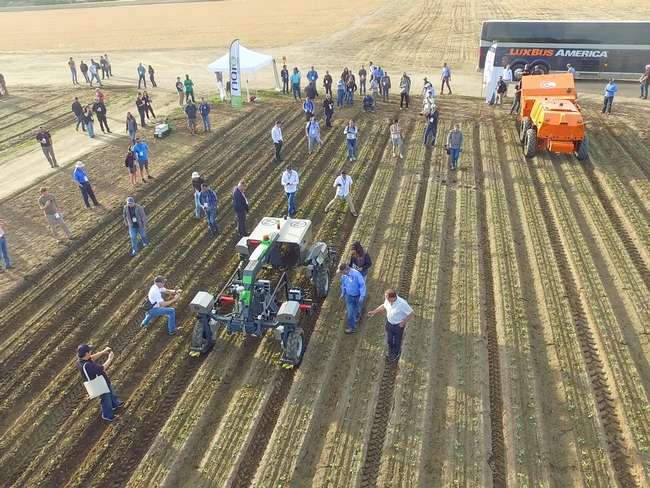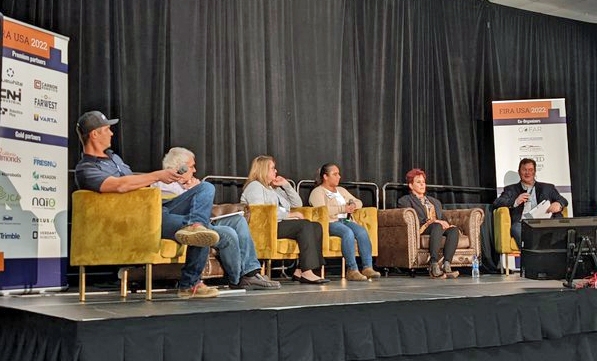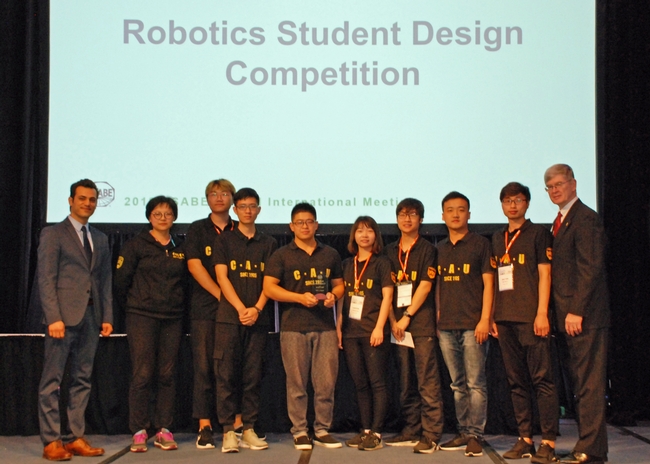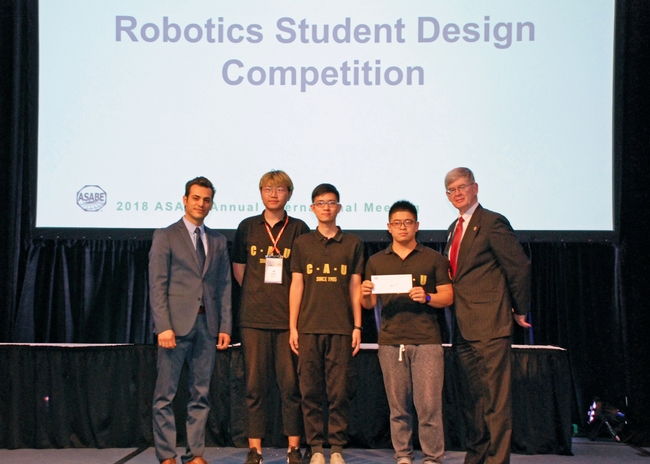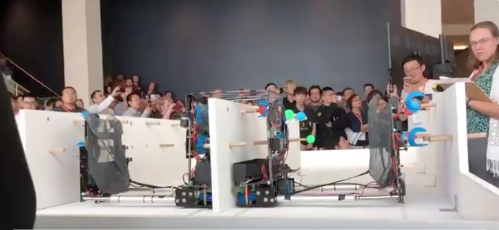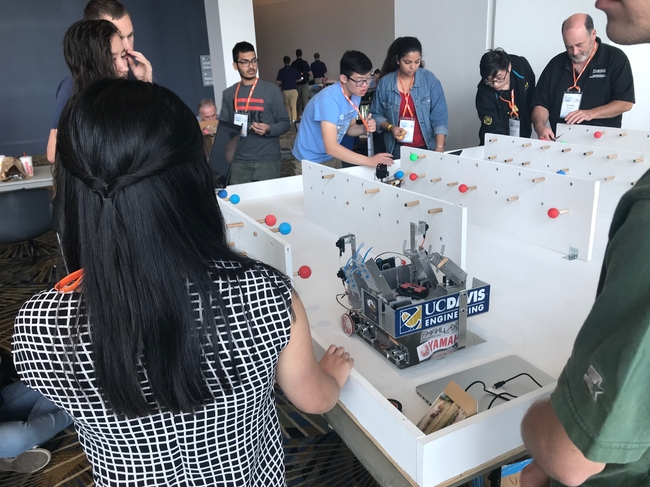- Author: Hanif Houston, Associate Director, Communications & Marketing for UC ANR's The VINE
College students are invited to develop a robot that makes farm work easier while competing for cash prizes and bragging rights in the Farm Robotics Challenge, a three-month robotics development competition running from Feb. 1 to May 13, 2023.
The challenge is being sponsored by The VINE, an initiative of the University of California Agriculture and Natural Resources focused on agricultural innovation, in partnership with the AI Institute for Next Generation Food Systems (AIFS), farm-ng robotics company, and the Fresno-Merced Future of Food (F3) Innovation coalition.
"Our primary objective for the Farm Robotics Challenge is to empower young innovators to explore careers in agriculture technology and innovation," said Gabe Youtsey, chief innovation officer for UC ANR and head of the VINE. "The agrifood technology industry is one of the most exciting and fastest-growing sectors in the economy right now, estimated to reach $30.5 billion by 2050. Yet, because of a lack of exposure or access, our brightest minds end up entering other sectors, taking their talents and abilities with them. We hope this new competition changes that and reverses the talent flow back into agriculture."
“In order to have a next-generation food system, we need next-generation agricultural robotics developers,” said Steve Brown, AIFS associate director. “There is tremendous innovation potential in this domain that just needs more connecting points to the coders and makers.
The Farm Robotics Challenge is open to any university or college in the U.S. Student teams will be asked to address a production farming topic on any crop or size of farm, with a desired focus on small farms, by automating an essential farm-related task using the farm-ng robotics platform. Each campus will need to purchase a farm-ng robot or borrow one to participate in the challenge.
Specific challenges will either be pre-identified for teams to choose from, or teams may choose to create additional or custom functionality to solve a self-identified challenge. Challenges will fit into one or more of the following categories: autonomy, artificial intelligence or attachment. Virtual training sessions will be offered throughout the competition to provide teams with expert guidance and technical help from AIFS, farm-ng, The VINE and other partners.
Student teams will be judged on the following criteria, with a grand prize and several specific prizes for top teams in each category: accuracy and completeness, market fit and commercial potential, design elegance and ease of use, cost-effectiveness, safety, interdisciplinary inclusion, and social and economic impact. Winners will receive cash prizes and connections to robotic companies for internships and jobs, among other benefits.
For more information, please visit the Farm Robotics Challenge website at https://farmbot.ai. If you have questions, contact HannaBartram, AI Institute for Next Generation Food Systems education and public engagement coordinator, at hcbartram@ucdavis.edu.
- Author: Hanif Houston, Associate Director, Communications & Marketing for UC ANR's The VINE
Agriculture and the global food supply is threatened by a range of issues including drought, climate impacts, increasing business costs and labor scarcity. To forge solutions to these issues and more, nearly 1,000 attendees from 26 countries converged in Fresno on Oct. 18-22 for the inaugural FIRA - World Ag Robotics Forum to be held in the U.S. The event was co-sponsored by UC Agriculture and Natural Resources' The Verde Innovation Network for Entrepreneurship, or the VINE.
Widely observed as a pivotal moment for agricultural technology and robotics in U.S. agriculture, the event was kicked off by California Department of Food and Agriculture Secretary Karen Ross and moved into a packed agenda with panel discussions, lightning talks and pitches where automation company representatives, academics and growers had the opportunity to share their challenges, concerns and hopes for the future of autonomous farming. The event culminated at CSU Fresno with more than a dozen companies offering in-the-field demonstrations.
Although growers are the target market for most of the equipment, the benefits of automation can ripple out into society, according to Glenda Humiston, University of California vice president for agriculture and natural resources.
“Technology can help us grow, harvest and distribute food more efficiently so that it can become more affordable and accessible for those who are food insecure,” said Humiston. “If we do this right, it's good for the whole community.
Here are a few themes and takeaways from this pioneering multi-day event.
Gaining on-farm use - Focus on end-user needs and ease of use
A major question speakers tackled was why more growers aren't yet integrating automation on their farms. Automation solutions exist and are being developed to help growers in nearly every aspect of running a farm — from planting, harvesting and weeding to addressing persistent labor shortages. Despite this, ag automation companies – both big and small – still face resistance from growers to adopting new technologies.
Part of the problem, Jeff Morrison of Grimmway Farms said during a panel on mechanization versus automation, is that companies pay more attention to their product than the needs of the grower. “Farmers want technology that fills a particular need,” he said. Anna Haldewang, the founder of InsightTRAC, agreed. “Don't be married to your product, be married to your customer.”
Chuck Baresich, president of the Haggerty AgRobotics Company, emphasized the importance of creating automation solutions that are simple and intuitive to use. “For a manufacturer, the first thing I'd tell them is don't overcomplicate things,” he said. “Make sure your robot can drive straight, start with that.”
Panels also touched on the technical, business and regulatory challenges to automating agriculture. The ag tech startup market is much younger than Silicon Valley, and we don't yet know the best route to establishing a successful business, Rob Trice of Better Food Ventures and The Mixing Bowl observed during a panel on robotic product development with key industry leaders, including Walt Duflock, vice president of innovation for Western Growers. That said, panelists identified three things that startups should do:
- Get prototypes into the field as quickly as possible to get performance data and get feedback, including from farmworkers, who may come up with multiple uses for the product.
- Be transparent about development to build partnerships with investors and growers. Partners understand that startups are a work-in-progress.
- Be ready to evolve and change your technology or your business to meet the customers' needs. Love the customer, not the tech.
AgTech, Labor and Farmworkers - Forging win-win opportunities
Labor issues also emerged as a persistent theme during the event. One of the major forces driving the need for automation in agriculture is persistent labor shortages. Simply put, farmers do not have sufficient labor to sustain their operations and are turning to agtech, robotics and automation to fill the gap. At the same time, as robotics and automation take hold in the agriculture industry, farmworkers and farm labor organizations are rightly concerned about the impact that the adoption of automation will have on agriculture jobs, in particular farm labor jobs.
Hernan Hernandez of the California Farmworker Foundation acknowledges the labor concern, but also sees opportunity. “All of a sudden, you go from 100 individuals that are going to be able to harvest this season to now 10 that will harvest with a machine," he said. "But the way we look at it is as well, when we talk to farmworkers and engage them, and we look at data, there is also opportunity. We know a lot of the farmworkers want opportunities to further their skill sets.”
We've got to find ways to help our farm workers actually get the training they need to make use of this technology, which will give them a better quality of life.
This sense of optimism about the future of the farmworker was shared by Gabe Youtsey, chief innovation officer of UC ANR, who moderated a panel on the future of agricultural work. “California as a whole has begun recognizing the importance of creating the next generation of ag workers,” he observed, “and schools and industry have both taken notice.” Indeed, California community colleges have begun working on new relevant programs that translate directly to jobs, and the federal government has allocated $10 million going directly to Central Valley agricultural education and workforce development programs.
What's next?
The gathering also served as a platform for launching new technology initiatives. Youtsey, in collaboration with our partners at UC Davis AI Institute for Food Systems, announced the 2023 Farm Robotics Challenge at FIRA USA 22! We look forward to co-hosting this event!
It is clear that automation and robotics will play an increasingly crucial role in agriculture. Not only in addressing the pronounced labor shortage in agriculture, but by creating new value creation opportunities related to resource efficiency, crop health, disease, harvesting and more.
“Our job at The VINE is to drive collaboration between industry, academia and government forward,” said Youtsey. “Robotics is moving very fast and there's a new set of players coming into the space. UC Cooperative Extension advisors can bring startups and farmers together in creative new ways during development and advance these solutions into commercialization faster.”
Co-sponsors of the conference included FIRA, Western Growers, University of California, Merced, California State University, Fresno and the Fresno-Merced Future of Food (F3) Innovation Initiative.
Industry sponsors included Bluewhite, Carbon Robotics, CNH Industrial, Far West Equipment Dealers Association, Grimmway Farms, Keithly-Williams Seeds Inc., Robotics Plus, VARTA AG, and Sonsray Machinery, LLC.
For more information
- Subscribe to the FIRA Newsletter HERE and check the website for future events.
- Interested in the 2023 Farm Robotics Challenge?Learn more at https://farmbot.ai.
- Author: Pamela Kan-Rice
Among the advanced teams, the University of Georgia, University of Florida and UC Davis finished second, third and fourth, respectively. Zhejiang University and Clemson University claimed those runner-up spots among the beginner teams. The beginners' race was especially tight, with the top two teams achieving perfect scores. CAU used speed to edged out Zhejiang, completing the required technical task one second faster than Zhejiang. Teams from Cal Poly (6th place) and UC Merced (7th place) also competed on the beginners board.
“All the teams incorporated innovative solutions in their robot designs,” says ASABE member Alireza Pourreza, University of California Cooperative Extension agricultural mechanization specialist, who coordinated the 2018 event.
This year's challenge involved identification, sorting, and harvesting of apples. The robots were required to autonomously harvest “apples” on a field measuring 8 feet by 8 feet. The robots identified and selected eight mature apples (red ping-pong balls), removed and disposed of eight diseased or rotten apples (blue ping-pong balls) and left eight immature apples (green ping-pong balls) on the tree.
"China Agricultural University's Dream team presents one of the more prodigious designs in competition, covering two lanes at once and picking apples flawlessly," tweeted Michael Gutierrez, a University of Florida Extension water specialist, @IrriGatorUF https://twitter.com/IrriGatorUF/status/1024285164682264577.
“The increasing interest in the ASABE robotics competition every year reflects a global response to the need of automation and robotics in agriculture,” explains Pourreza, who is based at UC Davis. “We aim to motivate young agricultural engineers to engage more with robotics and acquire an early-career experience that will prepare them for the future of agriculture and smart farming.”
Fifteen university teams from the U.S., Canada and China competed in this year's contest. Sponsored by the American Society of Agricultural and Biological Engineers, the ASABE Robotics Student Design Competition allows undergraduate and graduate students to develop skills in robotic systems, electronics and sensing technologies by simulating a robotics solution to a common agricultural process.
Founded in 1907, ASABE is an international scientific and educational organization dedicated to the advancement of engineering applicable to agricultural, food and biological systems.
MORE INFORMATION: 2018 ASABE robotics competition website: https://www.asabe.org/Awards-Competitions/Student-Awards-Competitions-Scholarships/Robotics-Student-Design-Competition
Video of 2016 competition: https://www.youtube.com/watch?v=U1ymUiCr3Mc
Video of 2017 competition: https://vimeo.com/250379863

